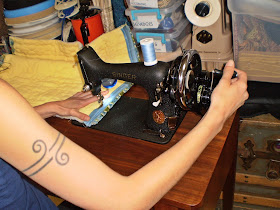Here at the DragonPoodle Test Kitchen, we seek to answer the questions it would NEVER occur to you to ask.
Such as this one: Can you wash Singer buttonholer cases in the dishwasher?
As mentioned before, I am always looking for the easy way out. That is NOT a good personality trait for someone who collects vintage sewing machines, btw.
 |
| before, obviously |
 |
| after, just as obviously |
The answer is a resounding YES. Finally, something was easy. There was minor paint loss off of the button snaps on the front, but nothing I couldn't live with.
I have quite a collection of buttonholers, including a green and a pink Jetson. I did NOT put those in the dishwasher. They have smooth surfaces and didn't need it, plus I was chicken. I love those things.
I ran them on a regular cycle, and about halfway through I opened up the dishwasher and flipped them upside down. I took them out before the rinse and dry cycles. I wanted to spare myself the scrubbing but not stress them out too badly.
The green ones are for low shank machines, and will work on ANY brand low shank machine, straight stitch OR zig-zag. The red ones are for slant shank machines, also straight (Singer 301) or zig-zag (400, 500, 600 series. Even beyond, if you are foolish enough to venture into the later Touch 'N Swears).

Did you know that all of these work on straight or zig-zag machines? I didn't, until I started messing around with them in preparation for bestowing a 401 on a friend of the DD.
Did you know that this model and the Jetsons model are identical except for the housing (metal housing in the rectangular boxes, plastic housing in the Jetsons boxes). Just remember to set your machine for straight stitching and let the buttonholer do all the zig-zagging by itself.
They make beautiful buttonholes. You do need to stitch out some tests on your fabric. Play around with the width settings and tension. Use stabilizer. Just like machine embroidery, when in doubt use MORE stabilizer. It really is easy if you are willing to take a bit of time up front to test stitch.
There's a later model that came in a cardboard box, and its mechanism is different. It has plastic cams and has 20 of them, versus the 10 available for the earlier ones. I just love me some vintage Singer buttonholers.
And, speaking of mechanically washing vintage sewing items, a fellow showed up briefly on one of the boards and described how he had cleaned some treadle irons: he put them in the back of his truck and drove through the car wash.
You can imagine for yourself the HOWLS of OUTRAGE that greeted his comment. Needless to say, he has never been heard from again.
So be gentle with those less knowledgeable than yourselves. Or St. Peter may greet YOU with a howl of outrage when you meet him at the Pearly Gates. and you would never be heard from again.
We would miss you. You DO know that there are hand cranks in heaven, don't you? The treadles are too heavy, they would fall out of the bottom of the clouds.











